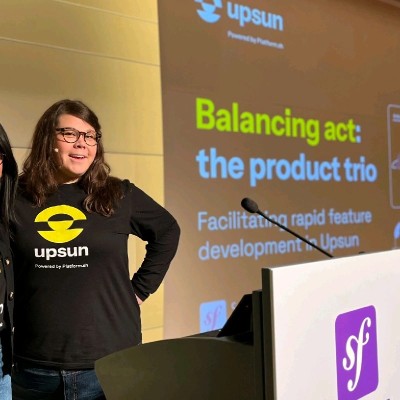Product, engineering, design: A guide to effective collaboration
Product, Engineering, and Design need to work together in a healthy and positive way to ensure smooth, quality feature development. Often the elephant in the room is, who is in charge? We discuss the answer to this question: surprise, it’s not one single person or group. Then we look at how to use this answer to your development cycles advantage and how it can open doors to happy and productive teams, and facilitate rapid feature development.
Join Shawna Spoor and Sukhman Virk as they dive into examples of how this worked well during the development of Upsun and when it didn’t work so well.
A bright, new offer powered by Platform.sh—adopted (and ❤️) by 16,000+ developers, 7,000 customers, and proven over the last 8 years—Upsun provides out-of-the-box capabilities that serve as the launchpad for creative development teams’ out-of-the-box thinking. A single, fully managed, self-service PaaS for development teams who just want to build their next, great application.
Links to check out: 👉 Get your free Upsun trial: https://brnw.ch/21wFxKr 👉 Learn more about Blackfire: https://brnw.ch/21wFxKp 👉 Get started with Platform.sh: https://brnw.ch/21wFxKj
Key moments: 00:00 - Intro 04:18 - What is a Product Trio?
- Explanation of the product trio concept
- Collaboration among product, design, and engineering teams
05:27 - Product Management Explained
- Definition and role of product management
- Importance of guiding and driving the product lifecycle
06:23 - History of Product Management
- Origins of product management
- Development of the concept over time
07:52 - Product Management Process
- Stages of the product management process
- Discovery, strategy, roadmap, development, and launch
09:00 - Product Design Explained
- Role of product design
- Importance of user research, ideation, and prototyping
10:45 - Engineering Explained
- Role of engineering in product development
- Importance of feasibility, context, and managing technical debt
12:32 - How the Product Trio Works Together
- Collaboration among product, design, and engineering
- Importance of communication and shared goals
13:12 - Initiative Structure
- How initiatives are structured
- Cross-functional teams and their roles
14:16 - Why Initiatives Work
- Benefits of initiatives
- Clear expectations, shared goals, and autonomous decision-making
15:54 - What a Healthy Working Relationship Looks Like
- Characteristics of a healthy team
- Communication, trust, respect, and collaboration
17:41 - What an Unhealthy Working Relationship Looks Like
- Characteristics of an unhealthy team
- Poor communication, misalignment, and lack of trust
20:11 - Failed Delivery Example: Upsun Trials
- Case study of a failed initiative
- Challenges and lessons learned from the Upsun trials
22:05 - What Went Wrong with Upsun Trials: Engineering Perspective
- Engineering challenges during the Upsun trials
- Technical debt and communication gaps
24:06 - What Went Wrong with Upsun Trials: Product Design Perspective
- Design challenges during the Upsun trials
- Misalignment and unclear implementation
25:33 - What Went Wrong with Upsun Trials: Product Management Perspective
- Product management challenges during the Upsun trials
- Lack of ownership and unclear scope
27:09 - Successful Example: Flexible Resources
- Case study of a successful initiative
- Development and benefits of flexible resources
29:01 - Why Flexible Resources Worked: Engineering Perspective
- Engineering success factors
- Open communication and clear goals
30:35 - Why Flexible Resources Worked: Product Management Perspective
- Product management success factors
- Clear scope and iterative development
32:10 - Conclusion
- Summary of key points
- Importance of communication and trust in a product trio
33:41 - Q&A, and Closing Remarks

